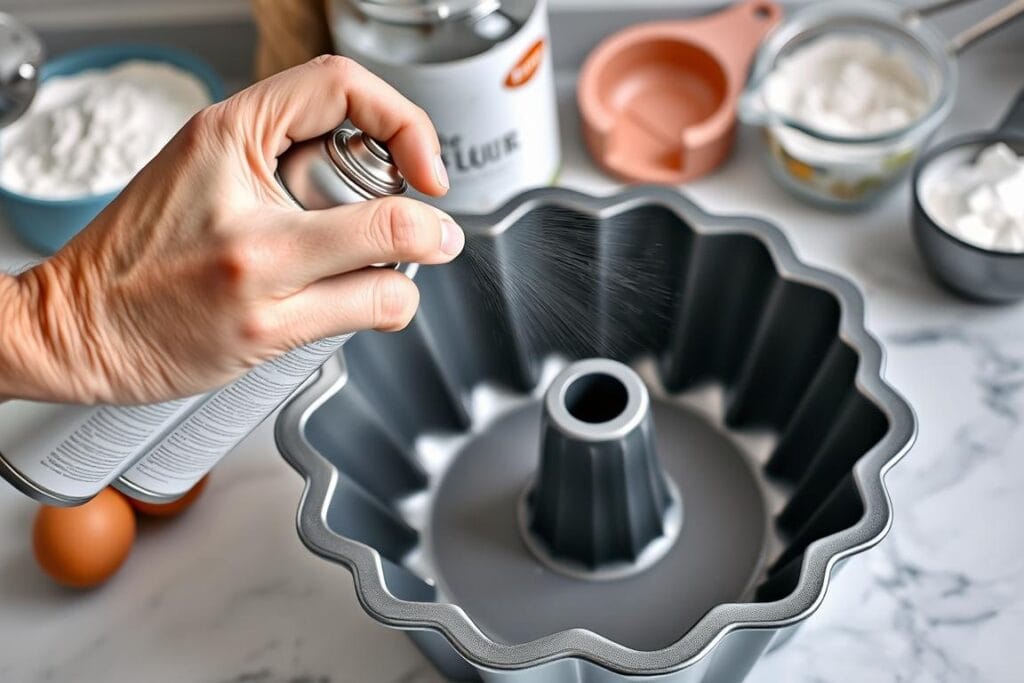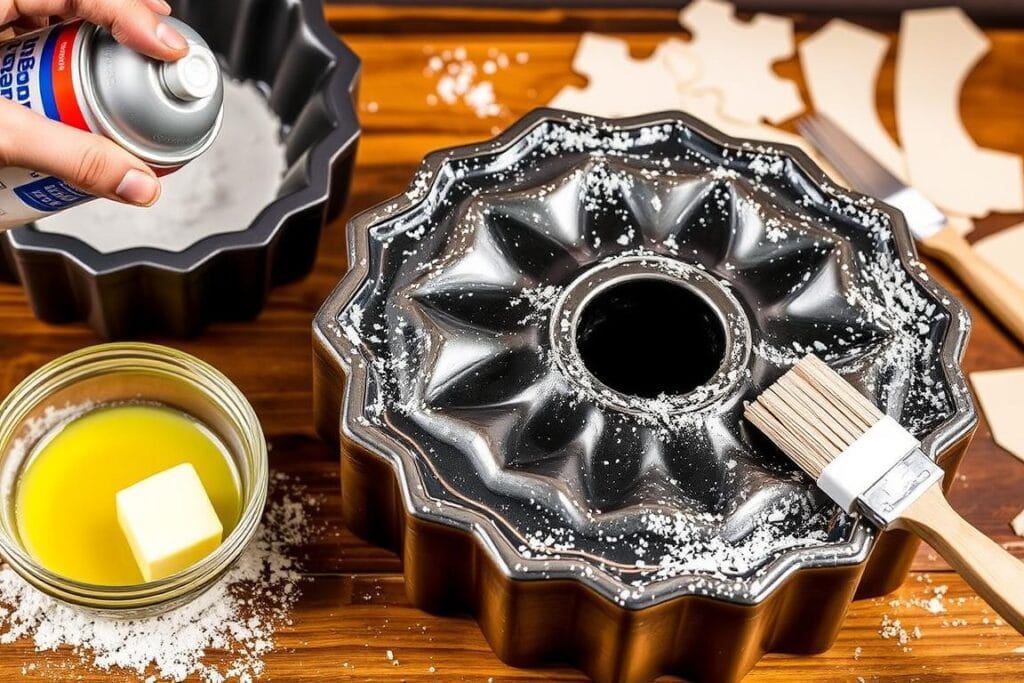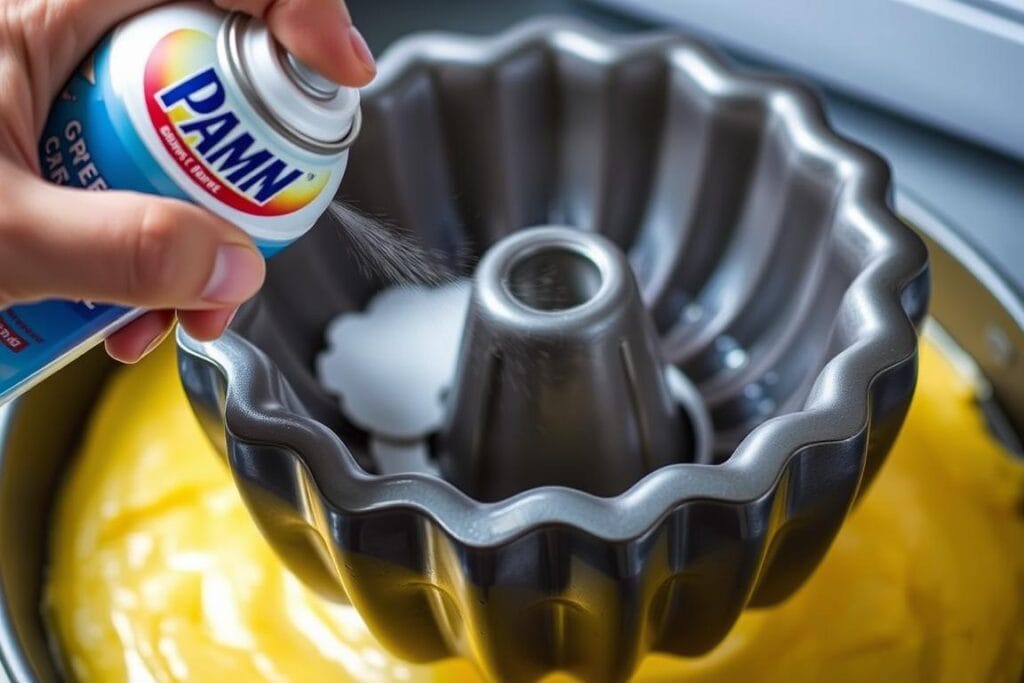Key Takeaways
- Cooking spray is not always the best option for bundt pans
- Proper greasing techniques are essential for cake release
- Different pan materials require different greasing methods
- Homemade greasing solutions can be more effective than commercial sprays
- Temperature and timing play critical roles in cake release
Understanding Cooking Sprays and Bundt Pan Preparation
Choosing the right cooking spray is key for nonstick baking. Pam cooking spray is a favorite among home bakers for easy bundt cake release. Knowing the differences in cooking sprays can greatly enhance your baking results.
Types of Cooking Sprays Available
Today, there are many cooking sprays for various baking needs:
- Coconut oil-based sprays
- Canola oil cooking sprays
- Olive oil cooking sprays
- Baking-specific sprays with flour
How Cooking Sprays Work
Cooking sprays create a thin oil layer to prevent cake batter from sticking. The propellant spreads the oil evenly. This ensures the cake comes out smoothly after baking.
For detailed bundt pans, specialized baking sprays like those with added flour are a great option. They ensure even coverage and simplify the process, especially for intricate designs like the ones featured in the Cinnamon Roll Bundt Cake recipe.

Benefits and Limitations of Cooking Sprays
| Benefits | Limitations |
|---|---|
| Low-calorie application | Potential surface buildup |
| Quick and easy to use | Less flavor compared to butter |
| Uniform pan coverage | May affect nonstick pan coating |
When using Pam cooking spray for bundt cake release, apply a generous, even coating. Make sure to rotate the pan for complete coverage. This prevents sticking and ensures a perfect cake presentation.
“The right cooking spray can make the difference between a flawless bundt cake and a frustrating baking experience.”
The Best Methods for Greasing a Bundt Pan

Mastering bundt pan preparation is key for a perfect cinnamon swirl cake. The bundt pan’s unique shape needs special care. This ensures your cake comes out smoothly without sticking.
There are several nonstick baking techniques to get great results. Let’s look at the top greasing methods:
- Vegetable Shortening MethodVegetable shortening is better than butter for greasing. It prevents too much browning and is dairy-free.
- Flour Coating TechniqueAfter greasing, dust with flour or unseasoned breadcrumbs. This adds an extra layer against sticking.
- Specialized Baking SpraysUse baking sprays made for complex pan designs. They cover all areas well.
Pro Tip: Use a roll of plastic wrap sprinkled with sugar or flour. It helps spread the coating evenly in your bundt pan.
Here’s a quick comparison of greasing methods:
| Method | Pros | Cons |
|---|---|---|
| Vegetable Shortening | Even coating, no browning | Requires flour dusting |
| Butter | Flavor enhancement | Potential excess browning |
| Baking Spray | Convenient, quick application | May not work with all pan designs |
Remember to fill your bundt pan no more than 3/4 full. This prevents overflow and ensures a perfect cake structure.
Creating the Perfect Cinnamon Roll Bundt Cake
Baking cinnamon desserts can turn your kitchen into a sweet paradise. The cinnamon roll bundt cake is a favorite, blending sweet breads with a fancy cake look. With simple baking steps, you can make this tasty treat.
Essential Ingredients for Success
To make a top-notch bundt cake, you need the best ingredients. Here’s what you’ll need:
- 5 large eggs (for moisture and tenderness)
- All-purpose flour (or gluten-free Bob’s Red Mill alternative)
- Granulated sugar
- Ground cinnamon
- Unsalted butter
- Vanilla extract
- Baking powder
- Whipping cream or sour cream
Step-by-Step Mixing Process
Making the perfect cinnamon dessert needs focus. Start by mixing butter and sugar until it’s light and fluffy. Add eggs one at a time, making sure each is mixed well. Mix dry ingredients separately, then fold them into the wet mix.
“The secret to a perfect bundt cake is in the careful mixing and layering of flavors.” – Baking Enthuasiast
Proper Pan Preparation Techniques
Your bundt pan is key to success. Pick a 10-15 cup pan and prepare it well. Use a baking spray with flour or grease it carefully to help your cake come out right. Make sure the cinnamon swirl is spread out evenly for great flavor.
Here are some baking tips for your cinnamon roll bundt cake:
- Bake at 350 degrees F
- Cooking time: 50-60 minutes
- Yield: Approximately 12 servings
- Total prep time: 50 minutes
With these easy steps, you’ll make a stunning cinnamon dessert that will wow everyone.
Common Issues When Using Cooking Spray in Bundt Pans
Dealing with bundt cake troubles can be tough, thanks to nonstick spray problems. Cooking sprays might seem handy, but they can lead to baking issues. These issues can ruin your cake’s quality.
Here are the common problems you might face with cooking spray in your bundt pan:
- Excessive cake edge browning
- Unwanted crust formation
- Potential pan surface deterioration
- Inconsistent cake release
Different pan materials react differently to cooking sprays. Nonstick bundt pans can develop buildup over time, which can change your cake’s texture and look. Some sprays can leave a greasy residue that affects the cake’s taste.
“Not all cooking sprays are created equal – choose wisely for your baking needs.”
Professional bakers suggest picking your greasing method carefully. This depends on your bundt pan and recipe needs. Pans with complex designs might need more precise greasing for a perfect cake release.
| Cooking Spray Issue | Potential Consequence |
|---|---|
| Overuse of spray | Greasy cake texture |
| Incompatible pan material | Surface degradation |
| Incorrect application | Uneven cake release |
Knowing these common problems can help you make better choices for greasing your bundt pan. This way, you can get bakery-quality results.
Alternative Greasing Methods for Bundt Pans
Mastering how to get a bundt cake out of the pan is more than just using cooking sprays. Professional bakers have found many ways to make sure your cake comes out perfectly every time.
To get a cake that slides out easily, you need to know about different greasing methods. Let’s look at some proven techniques that will make your baking better.
Butter and Flour Combination
The butter and flour method is a top choice for bakers who want smooth cake edges. Here’s how to do it:
- Softened butter is best for greasing the pan sides
- Use a pastry brush for an even coat
- After buttering, dust with flour
- Tap out extra flour to avoid clumps
Shortening Techniques
Using solid vegetable shortening is another great way to prepare your bundt pan. Many pros prefer this method, saying it works well for detailed pan designs.
“A thin, even layer of shortening ensures your cake releases perfectly every time.” – Professional Baker’s Tip
Natural Oil Options
Trying natural oils can add special touches to your baking. Here are some options:
- Coconut oil for a hint of tropical flavor
- Olive oil for a rich, smooth texture
- Vegetable oil for a neutral taste
For chocolate cakes, use cocoa powder instead of flour. It helps avoid white residue and makes the cake look better.
Trying out different methods for getting a bundt cake out of the pan can help you find what works best for you. Each method has its own benefits for making a beautiful bundt cake.
Impact of Pan Material on Greasing Methods
Choosing the right bundt pan material is key to baking success. Each material needs its own care to ensure your cake releases perfectly and bakes well.
- Aluminum: Lightweight and conducts heat evenly
- Cast Iron: Keeps heat well and has natural nonstick
- Steel: Durable, can have nonstick coatings
- Silicone: Flexible but might not give crisp edges
The material of your pan affects how you should prepare it for baking. Cast aluminum pans, like those from Nordic Ware, have precise designs and even heat. They need careful greasing to keep the pattern details.
“The right pan makes all the difference in creating a perfect bundt cake.” – Professional Baker
Cast iron pans get a natural nonstick surface over time. With the right seasoning, you’ll need little greasing. Nonstick-coated steel pans are easy to use but need gentle care to avoid scratches.
Silicone pans are flexible but might not give you the traditional crisp bundt cake edge. When using silicone, be extra careful with greasing to ensure the cake comes out clean.
Professional Tips for Perfect Bundt Cake Release
Mastering the art of bundt cake release is key. It’s not just about greasing the pan. It’s about precision and strategy to get your cake out perfectly.
Temperature Considerations
Temperature is very important for cake release. Let your bundt cake cool for 10-15 minutes after baking. This lets it set a bit while staying warm enough to remove easily.
- Remove cake from oven and let sit in pan
- Wait 10-15 minutes before attempting release
- Maintain consistent room temperature
Timing Techniques
Timing is key in baking. Gently tap the pan’s edges to loosen the cake. For tough cakes, a warm, damp towel under the pan can help with steam.
| Technique | Purpose | Duration |
|---|---|---|
| Gentle Tapping | Loosen Cake Edges | 30-45 seconds |
| Damp Towel Method | Create Steam Release | 2-3 minutes |
Cooling Methods
Proper cooling is as important as greasing. Always cool on a rack to prevent soggy bottoms. This method ensures even cooling and keeps the cake’s shape.
“Perfect cake release is an art form that requires patience and precision.” – Professional Baker’s Wisdom
Follow these tips to make your cake releases easy and perfect. You’ll show off your baking skills with every delicious slice.
Maintaining Your Bundt Pan’s Non-Stick Surface
Keeping your bundt pan’s nonstick surface in top shape is key. It’s all about the right care and maintenance. This way, your bakeware will last longer and bake better for years.
To keep your pan’s nonstick surface in great shape, follow these tips:
- Avoid using metal utensils that can scratch the surface
- Skip abrasive cleaning materials like steel wool or harsh scrubbers
- Always hand wash with gentle, warm soapy water
- Dry thoroughly after each use to prevent water spots
“A well-maintained bundt pan is the secret to perfect baked creations every time.”
Different bundt pan materials need special care. For instance, aluminized steel pans like the USA Pan Bakeware Fluted Tube Cake Pan need extra care to keep their nonstick coating in top shape.
| Pan Type | Cleaning Recommendation | Maintenance Difficulty |
|---|---|---|
| Aluminized Steel | Gentle hand washing | Low |
| Nonstick Coated | Soft sponge, mild detergent | Medium |
| Uncoated Metal | Immediate drying, light oiling | High |
Re-seasoning with a light vegetable oil coating can help keep the nonstick surface. Store your bundt pan carefully. Avoid stacking or placing heavy items on top to prevent damage.
When to Choose Cooking Spray Over Other Options
Choosing cooking spray can change your baking for the better. It’s great for those who care about health and don’t have a lot of time. With just 7 calories per spray, it’s a low-fat choice that makes prep easier.
- Quick baking prep with even coating
- Reduced cake breakage during removal
- Minimal calorie and fat content
- Consistent coverage in tricky pan designs
A survey shows why cooking spray is so popular. Eighty-five percent of pros use it for bundt pans because it works so well. Research also shows a 70% drop in cake breakage with cooking spray over old methods.
“Cooking spray offers a modern, efficient approach to preparing bakeware with minimal effort and calories.” – Baking Professionals Association
Here are times when cooking spray really comes in handy:
- Low-fat baking projects
- Pans with complex shapes
- Quick preparation needs
- Recipes needing little added fat
| Greasing Method | Calories | Fat Content |
|---|---|---|
| Cooking Spray | 7 calories | 1 gram |
| Butter | 102 calories | 12 grams |
| Olive Oil | 119 calories | 14 grams |
Keep in mind: Cooking spray is convenient, but it’s not for every recipe. Some dishes need butter’s flavor or the texture from traditional greasing.
Conclusion
Getting perfect bundt cake success is all about mastering baking techniques. Your path to a flawless dessert starts with the right pan prep. You can use cooking spray, butter, or shortening, each with its own perks.
Experimenting with greasing methods is key to a cake that releases perfectly. The type of pan, recipe complexity, and your taste preferences matter a lot. Professional bakers suggest trying different greasing techniques to find what works best for your recipe.
Baking skills grow with practice. Begin by knowing your pan and the recipe’s needs. Some cakes need a butter and flour mix, while others do well with cooking spray. Remember, every try gets you closer to a perfect, stunning bundt cake that will wow everyone.
Your bundt cake success is about patience, practice, and a love for learning. Don’t get down if you face early setbacks. With the right techniques and creativity, you’ll soon make beautiful bundt cakes that are as delicious as they look.

